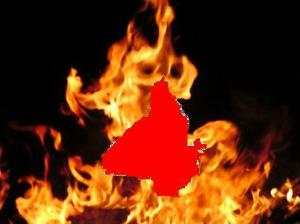The vicious path of red terror

The barbaric and dirty attack by the Maoists in West Bengal, on Feb.15, 2010 claimed the precious lives of 24 jawans. After a few days the red terror again claimed the lives of 11 innocent villagers in Bihar (Feb.18, 2010). The Government of India has described the left extremist movement as the greatest internal threat of the country. Yes, through these kind of inhuman acts Maoists are proving again and again that they are the greatest internal scourge of our times. It undermines peace, democracy and freedom endangering the humankind as a whole.
The figures computed by the Ministry of Home Affairs shows that, from 2000 to 2007, the Maoists had brutally killed 4067 civilians in various parts of our country. The present scenario necessitated to examine the nature and beginning of Maoist movement in India. Where the movement originate? Does it have a strong ideological background? Then for what purpose they are killing innocent people? Let us go back to the old Naxal Bari village…
The left wing extremist movement, which we popularly called naxal revolution, began as a peasant uprising in May, 1967 at Naxal Bari, a small village in West Bengal. During that time feudalism was in full swing at Naxal Bari, villagers were under the clutches of feudal land lords. Obviously the movement had started as a protest against feudal exploitation and oppression over rural power. But unfortunately the alien ideology of communism exploited the ignorance of villagers under two communist revolutionaries Charu Majumdar and Kanu Sanyal. They defined the objective of the new movement as seizure of power through an agrarian revolution and considered communist China as their mentor. Slogans such as ‘China’s Chairman is our Chairman’ suddenly sprouted on Kolkata walls. China’s official radio, Radio Peking hailed the Naxal Bari events as the spring thunder. Through his writings Charu Majumdar imparted a taste of violence in the youth not only against landlords but also against the country.
With the formation of Communist party of Marxist Leninist (CPI (ML)) by Charu Majumdar in 1969, the naxal movement spread its tentacles across various parts of the country. But the police had quelled the Naxal Bari uprising and Charu Majumdar was killed in the police custody on July 28, 1972. Majumdar’s death caused a serious debacle to the movement and it became inactive for some period. But their ‘agrarian revolution‘turned to a cruel blood war.
By the 1970s, the Naxal movement had spread far-flung areas like Kerala and Andhra Pradesh in the south, Bihar in the east and Punjab in the north. But the movement was fragmented into several disputed factions. Among this, Peoples War Group based on the villages in Andhra Pradesh and Maoist Centre focusing on the jungles of Bihar were the prominent organizations. After dissolving the above two groups into one, the Maoist movement again strengthened in 2004.
As of 2009, Naxalites are active across approximately 220 districts in twenty states of India, accounting for about 40% of India’s total geographical area. They are especially focusing in an area known as the Red corridor, where they control 92,000 sqkms. According to Research and Analysis Wing (RAW), 20,000 armed cadre Naxalites were operating apart from 50,000 regular cadres working in their various organizations.
This growing influence of Naxalism prompted Indian Prime Minister Dr. Manmohan Singh and Home Minister P. Chidambaram to declare them as the most serious internal threat to India’s national security (2010). Also the government has started a military operation ‘Green hunt’, to curb the Naxal movement. But the recent attacks in Bengal and Bihar by the Maoists was a reflex action to this operation Green hunt. Thousands of Indians have lost their lives in the war against red terror; in tackling the terror what we need is a strategic vision. Along with the military action the state governments have to find solutions for the miserable life of people in Naxal dominated areas. Also the nationalist forces should come to the fore to impart patriotic values to the people living in those areas.
Welcome to Haindava Keralam! Register for Free or Login as a privileged HK member to enjoy auto-approval of your comments and to receive periodic updates.
Latest Articles from Divisive Agenda
- എന്റെ സത്യാന്വേഷണം – ക്രിസ്തുമതത്തില് നിന്ന് ഹിന്ദുത്വത്തിലേക്ക്
- Apologize or Face the Consequences
- Rewards – Punishments – Heaven – Hell and Jihad
- State Sponsored Divisive Wall – A Look Back
- In’s and Out’s of Love Jihad
- Brutal Assaults, Death Threat Awaits your Kid, If not Ready to Join SFI
- SFI Blasphemy: Hindu Deities Denigrated in Kerala Varma College
- Pinarai Vijayan’s Comments on Yoga Stems from Inferiority Complex of a Commie
- HC Directive – Blow to Love Jihadis & ISIS Recruiters
- Irom Sharmila, welcome to Kerala!

